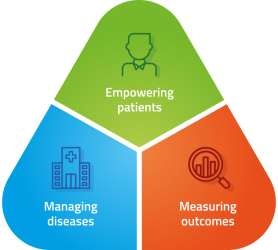Article written by Vincent Keunen, founder of Andaman7. @vincentkeunen 
Andaman7 technology series #2 - A new paradigm: distributed collaborative EHR
This is the second article of our series dedicated to the technology of Andaman7. Our goal with this initiative is to contribute to the field of “health IT” by discussing challenges and possible solutions (more details on these challenges in our article #1).
Article #1 was an introduction to health IT challenges. To read it, go to: Andaman7 technology series #1 - Introduction.
The opinions in these series are our own. They are based on our 25 years of experience in the field building large scale EHRs (Electric Health Record) and health information exchange systems (1). We share them in good faith to help move the needle forward and inspire others. And of course, we also want to promote our own Andaman7 initiative, a project by patients for patients (2). Terms and acronyms are explained in our lexicon (3). We are open to and welcome discussion on these topics. You can find us on LinkedIn, Twitter and Facebook and we can also discuss on other media you would like to invite us to.
Andaman7 is, we believe, one of the first, if not the first distributed collaborative EHR (4).
 With Andaman7 and its many connectors to existing systems, the EHR (Electronic Health Record) becomes distributed and modified collaboratively, in real time, by many actors. This is great: finally the promise of having all your health data in real time becomes real. But this comes with many technical challenges.
With Andaman7 and its many connectors to existing systems, the EHR (Electronic Health Record) becomes distributed and modified collaboratively, in real time, by many actors. This is great: finally the promise of having all your health data in real time becomes real. But this comes with many technical challenges.
Who can modify data? Who can access it? Can information be deleted? How do I know who modified data? Is the data valid? Which is the more recent data? What data is from a health professional and what data is from the patient? Does device data come from a medical grade or consumer type device? Can the information be accessed in another language? Besides the obvious use of EHR for care, what about research for innovative treatments and medical devices?
Andaman7 provides the foundations to solve all those complex health IT problems. Thanks to our experience and a number of innovative technical solutions based on the most recent developments of software engineering. A number of these innovations will be described in the articles of this “technology series”.
For example, every piece of information in Andaman7 (every value in every “data field”) is marked with a universally unique id (UUID), a date-time stamp and a source. Every piece of data is therefore uniquely identified and there can never be a “data conflict”, even if the data is “modified” at various places at the same time by multiple actors. The combination of source / date-time stamp / UUID guarantees that no data will ever be in conflict. And the apparent “modification” is actually (internally) an addition to the history of that data field. We just store all instances of the data and they can all be viewed in the “history” of the data field by all users. This is critical for transparency and traceability. Even for fields that usually don’t have a history in legacy systems (like last name, gender,...), Andaman7 keeps a record of all changes. This history information is also shared along the current, fresh, data value (if the owner of the data decided to share that data field, of course).
There is also another benefit, which will become more and more important with the number of contributors to a “health record”, especially if those contributors are not healthcare professionals: everyone reading the health record will know where the data comes from and when it was generated. This is useful to give different credit to a piece of data coming from a patient or a healthcare professional, to data coming from a consumer grade device or a medical grade one, to data coming from one laboratory system or another one, etc.
We built those foundations for patients first, with strong support for care actors (doctors, hospitals, all health professionals) and for research actors (life science actors, like the pharmaceutical industry, medical device manufacturers, CROs, academic research,… but also health and social science research).
Because patients want privacy, but also excellent care and efficient new treatments.
Our next article will be on “Peer-to-peer health data exchanges”.
Stay tuned.
To read the summary of these articles, combined into our white papers, go to:
- Andaman7 Technical Innovations: http://bit.ly/a7TechInno
- Andaman7 advanced health data management: http://bit.ly/a7DataMan
(1) In a previous company, we built a prevention-focused EHR that is today used for some 1 million people (most are in good health, some are patients). We also built the technology for the two largest “medical messaging systems” of Belgium, still being used today by 90% of all hospitals and doctors.
(2) Read our story.
(3) Consult the lexicon. It's a work in progress. Don’t hesitate to make suggestions and remarks to support@andaman7.com.
(4) We want to stay humble and we don’t pretend to know all systems out there, but up to now, we have not yet seen an EHR that is really collaborative and distributed by design. And we gradually discover all the benefits of this approach.








